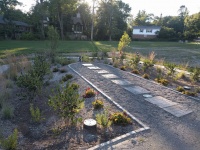Stone
Revision as of 18:30, 2 October 2017 by Alexveglio (talk | contribs)
For advice on aggregates used in underdrains, see Gravel
Stone can serve as a low maintenance decorative feature, but it may also serve many practical functions in an LID practice. Typical stone functions in LID and direction on selection are provided below:
Dissipate flow and prevent erosion at inlets and outlets
- Angular crushed stone, which will "knit" or lock together and be less likely to shift, is recommended, however, for aesthetic purpose smooth river run stone may be desired.
- The stone sizing is based on flow velocities at inlets and outlets, but typically ranges between 50 mm and 250 mm.
- The thickness of the stone bed is twice that of the largest stone diameter.
- To prevent erosion of soils beneath the stone and the migration of the stone into the soil, the stone bed should be underlain by a drainage geotextile.
Direct and spread flow throughout a large LID facility or to protect narrow channel sections where flow will concentrate
- While crushed stone will be less likely to shift, river run stone may be used to create a dry stream bed look.
- The sizing of the gravel will depend on the expected velocities.
